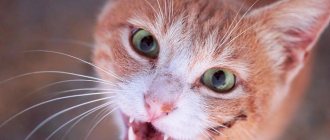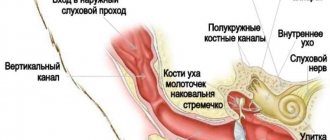Welcome, dear readers, to the cat care blog!
Information on how to cure a particular disease is a purely medical thing, but in what cases to seek help from doctors is useful for us to know!
And although today the reason for communication is very serious, as you will see for yourself, in the end everything will be fine, believe me, if the matter is not taken too far!
So what should you do if your cat has yellow discharge? But they are not only yellow!
Let's take a look at all the reasons for such phenomena, shall we? Caring and attentive owners need to be aware of what is happening in the animal’s body. Do you agree?
"What's happening?!"
A reasonable question if you suddenly notice something wrong under the tail of your always (and everywhere!) neat and tidy little cat!
And the reasons for the discharge, depending on its color, can be natural (due to physiological processes) and pathological:
- Transparent, homogeneous, odorless - the norm during the period of estrus, but if they last longer than three days, an odor appears, they become cloudy and yellow - immediately consult a veterinarian.
- White; sometimes yellowish; bloody - shortly before birth;
- Transparent; fawn or greenish - after the start of contractions, amniotic fluid flows out;
- From yellow or dark green to brown - after birth from several days to 3 weeks.
- If long before birth, they are gray, smell unpleasant, and appear in the form of pus - medical attention is required! This is also dangerous for kittens.
- Constant and watery, and sometimes with blood, is not the norm; this happens when the placenta does not leave after childbirth.
- Bloody, but behavior as in estrus (and there should be no blood normally) - these are symptoms of pyometra in an open form (purulent inflammation of the uterus); There are also other types of discharge: creamy; brown; yellow; green; pus mixed with blood. Without treatment - a fatal and painful outcome within a period of 2 days to 1-5 weeks from the onset of visible symptoms. But the closed form of pyometra... there are no visible symptoms - this is its danger! - after all, they notice it when it may already be too late.
- Pink or opaque (purulent) - urinary tract or uterine infections;
- Cloudy, yellowish, bloody, with an unpleasant odor - endometritis; sometimes it begins 2-3 days (!) after birth; “insidiousness” of endometritis: outwardly you feel good, estrus occurs, but pregnancy does not occur; if left untreated, the situation will worsen greatly;
- Drops or clots of blood - hematometer;
- Smearing or in the form of meager drops - hydrometer (the last two ailments are a threat to life).
- Bloody or purulent - the likelihood of cancer of the urogenital tract.
- Watery or mucous - inflammation of the vagina.
- Abnormal bleeding is a symptom of a bleeding disorder (it is difficult to distinguish from blood in the urine).
- Bloody, watery or purulent - injury or the presence of a foreign body in the vagina.
- Watery... feces - this happens in case of defects or fistulas between the rectum and vagina.
- Persistent - with a problem with the sphincter of the bladder or with an abnormal position of the ureter, then urine enters the vagina and irritates it, hence the constant discharge from it.
White vaginal discharge from a cat
The appearance of white discharge from the vaginal area and loop in a cat is provoked by factors of both physiological and pathological nature. Normal discharge includes white discharge during heat and pregnancy.
During estrus, initially clear mucus is released from the cat's loop, which subsequently becomes white and has no specific odor. In addition to discharge, the period of onset of estrus in a cat is characterized by a number of symptoms - the animal arches its back, actively calls for the opposite sex, and shows anxiety.
White vaginal discharge from a cat may appear during the last stages of pregnancy. The secreted secretion is mucous and whitish in color, which is associated with the release of the plug that covers the cervix during pregnancy.
Pathological processes developing in the reproductive system of females, in the first stages, can also be characterized by the appearance of whitish discharge. The main diseases identified in veterinary medicine in cats are:
- Vaginitis - characterized by the appearance of white exudate, indicating the development of an inflammatory process. Streptococcal and staphylococcal infections can provoke the development of vaginitis in a pet.
- Endometritis is a disease localized in the area of the uterine walls. At the development stage, endometritis is characterized by the appearance of copious mucous-type discharge, which later acquires a whitish tint. They are thick and have a strong, unpleasant odor. But the following options are associated with pathological processes.
- Pyometra is a dangerous disease that often affects unsterilized females. The owner can notice changes in the cat’s behavior at home, paying attention not only to the appearance of white vaginal discharge, but also to the symptoms accompanying the development of pyometra, such as a frequent urge to urinate, a tense and swollen abdomen. The appearance of discharge during the development of purulent inflammation in the uterine cavity is characteristic of the open form of the pathology. The closed form of pyometra is not characterized by the appearance of any discharge. Quite often, pyometra develops against the background of untimely treated endometritis. The danger of the pathology lies in the fact that the animal is at risk of peritonitis, blood poisoning, which ends in death in the absence of surgical intervention.
White discharge in the loop area can be caused by uncontrolled use of contraceptive hormonal drugs. Ignorant owners purchase drugs to regulate sexual heat in cats, without thinking about the consequences for the animal’s body. In addition to endometritis and pyometra, the female may develop malignant tumors in the uterus or appendages.
In order to prevent the development of life-threatening diseases, veterinary experts recommend routine sterilization of all females that are not planned for breeding.
Additional symptoms
For different diseases, the following are possible:
- increased and/or difficulty urinating, which is painful and can therefore cause anxiety and even aggression;
- it’s hard for the poor thing to go “big”;
- for a long time the cat rubs its butt on the floor (or rolls on the floor);
- licks himself from behind too often, because the discharge irritates the skin;
- complete apathy; drowsiness; vomit; fever; increased thirst; poor appetite; abdominal enlargement.
Prevention is the key to health!
Thus, not all prenatal discharge in cats is normal, and if any occurs, you should immediately contact your veterinarian.
Even with timely treatment, there is no guarantee of preserving the life of kittens (or even the cat itself), and therefore every effort must be made to avoid the development of this type of pathology:
- Remember that in healthy cats the development of birth pathologies is practically excluded. In general, carefully monitor her diet, choose only high-quality food, and bring her to the veterinarian for a preventive examination at least once a quarter.
- In the second half of pregnancy, try to isolate the cat in a room where there are no high pieces of furniture or sharp corners so that the pet cannot injure its enlarged belly.
- Be sure to get all vaccinations prescribed by your veterinarian, as they will reliably protect your cat from many infectious diseases.
- A pregnant cat should be protected from drafts, but at the same time make sure that she does not sleep near heating appliances. Sudden changes in temperature have a bad effect on the intrauterine development of fetuses.
- Make it a habit to carefully observe your cat’s behavior for at least ten minutes a day. The sooner you notice any deviations from the norm, the sooner you can help her.
Most importantly, remember that any discharge from a pregnant cat that appears no earlier than a couple of weeks before the “official” due date is potentially dangerous!
Of course, there are situations when they have a completely natural origin, but much more often their appearance is a consequence of severe pathological processes. Only an experienced veterinarian in a well-equipped clinic can save the life of a pet and her offspring.
A reason to consult a specialist!
In all of the above dangerous (!) situations, you should not risk the health of your tailed pet and “make a diagnosis” on Internet forums - “guess the tea leaves”, but it is better to consult with a veterinarian by toll-free phone, then make a house call or make an appointment , if required.
Then timely treatment will return the mustachioed and striped beauty to excellent health, and you will be in a good mood! And may it “never leave you again!”
Physiological reasons
Physiological are considered reasons that cause discharge due to the characteristics of the body. Before giving birth, the female will have a plug, which is also a hard clot of mucus that comes out before giving birth. It does not bode well: it is necessary to “remove” everything unnecessary from the surface of the labia and prevent the occurrence of infections as a result of the introduction of harmful bacteria during childbirth.
Discharge from a pregnant cat: bloody, yellow
After your cat gives birth, she may continue to have mucus coming from her vaginal opening and anus for some time. Color – reddish or dark brown interspersed with greenish color. The norm is 3 weeks after birth. Due to the fact that during childbirth the discharge is red (the cat has bloody discharge), after the birth of the kittens the mucus will also have a reddish tint, which will gradually turn into a brown tint and disappear.
Reference! True, during pregnancy, yellow mucus sometimes comes out - amniotic fluid.
But not everything is as simple as it seems. There are much more dangerous secretions that indicate the presence of health problems. If they are not related to pregnancy, then they are not difficult to recognize. The next step is to determine the type, cause and prescribe the correct treatment.
Dangerous diseases arise as a result of infections that enter the body through the external environment, contact with other animals and sexual intercourse.
Diagnosis and treatment
Since the ear is in close proximity to the main arteries and the brain, if there is any discharge, you should contact an otolaryngologist. As a rule, the diagnosis is clear already at the first appointment. In rare cases, additional procedures are prescribed: CT and MRI of the head and consultation with other specialists, for example, a traumatologist, if there is a suspicion of a traumatic brain injury.
If the diagnosis cannot be made immediately or the doctor has doubts, then additional examinations are carried out: a blood test, culture for bacterial flora, radiography or tympanometry.
Ear discharge is a symptom. Therefore, they do not treat it separately, but look for the underlying disease. But this does not mean that otorrhea can be ignored. Measures not taken in time lead to a decrease in hearing acuity, complete deafness, the process of metastases growing in other organs, the formation of sulfur plugs, etc.
Most ear diseases can be cured with conservative therapy: medications in various forms, procedures. Surgical intervention is prescribed for severe forms.
What to do if there is blood in the discharge
The appearance of blood in the discharge indicates a violation of the integrity of the mucous membranes. The next stages most often are infection, formation of pus and filling of the problem organ with it. In the absence of help, tissue ruptures and sepsis develops. There is a high probability of death, so with this symptom you need to take the animal to the veterinarian as quickly as possible.
It is not recommended to do anything on your own: blood can appear for several reasons. Due to self-medication, at best you will waste time, at worst you will aggravate the animal’s condition.











